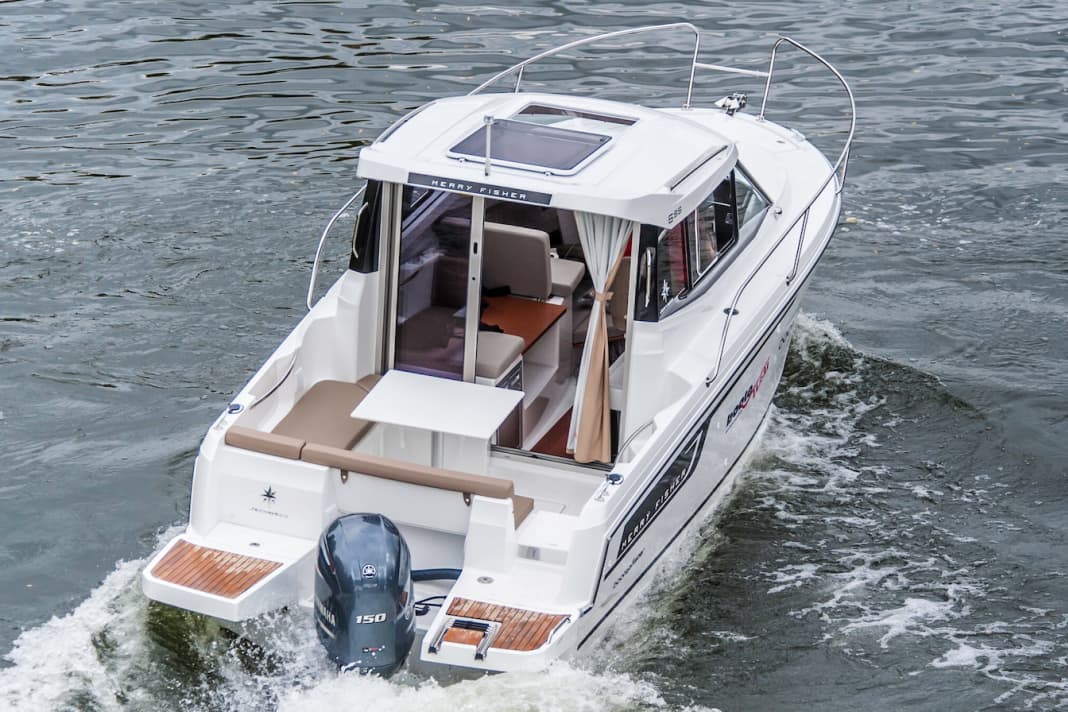






The French shipyard Jeanneau is currently building seven boats from six to nine metres in length with different cabin superstructures in the Merry Fisher series. They were originally designed for sport fishing and are powered exclusively by one or two outboard motors.
We sail a Merry Fisher 695, a classic-looking cabin cruiser with up to four berths and a separate "wet room", which you can also order.
The maximum motorisation is 175 hp. If you want to take it overland, you will need a trailer with a payload of 1700 kg or more, depending on the equipment, plus a suitable vehicle with a towing capacity of 2.5 tonnes or more.
In terms of workmanship, the boat makes a rock-solid impression both inside and out. If the test boat had not been soMany corners and edgesIf there were no cables and hoses to rub and bump against, the score would be better. Otherwise, everything fits.
With a motor and a cabin cruiser, a bow thruster like the one in the test boat is a helpful extra accessory;with crosswind and crosscurrent it helps when mooring and unmooring, even if our test boat is travelling forwards and backwards at slow speed to where it needs to go and a turning circle diameter is less than 2 ½ boat lengths.
As soon as the engine is turning at least 1500 rpm, you rarely have to correct your course, and waves generated by the boat hardly interfere.
The test boat begins to planing at 11 knots or 3000 rpm; at 21 knots (4000 rpm) you are travelling
at 21 kn (4000 rpm) you are travelling economically at fast planing speed and can cover 120 nm plus 15 % reserve.
Good: At full throttle, the engine remains 100 rpm below the permitted maximum speed and enables aMaximum speed of just over 33 knots. Foresight always remains optimal during the transition from displacement to planing speed, even if the engine is not fully trimmed.
The topic of extreme manoeuvres is brief, as the propeller tends to ventilate quickly if the curve diameters are less than two boat lengths when gliding.
And if the trim remains inOptimum driving positionthe propeller grabs air earlier and demands to be restarted. With a curve diameter of more than three boat lengths, it turns round normally.
During the 180° turns, it goes round in one go without the hull hooking or rocking. During the slalom test, the test boat swings slightly but safely over its longitudinal axis, and when the rudder is pulled, it safely follows the course taken.Course. This means that the driving characteristics can be rated as safe and problem-free overall, even in extreme cases.
When crossingWaves of commercial shipping On the Main, these are noticeable acoustically when travelling at speed, and when you drive over choppy water, it feels like you're rattling over cobblestones.
Sportiness is required to get into the driver's bucket seat. Once up there, we avoid pushing it forwards and sitting in the front area. It is mounted on a board which, when folded back, reveals the work surface of the galley below; the holding mechanism is only a small one,untrustworthy bar.
This has already proven in other tests that it does not hold. On the other hand, you can see in all directions as long as you are not bothered by the light-coloured surface reflected in the windows. Passengers have to convert the front part of the dinette to be able to look forwards when seated.
The dashboard is equipped with two Yamaha instruments andCompass in the centre of the boat in front of the windscreen is not really filled, so there is still enough space for a small chart plotter.
The outboard motor is firmly bolted to the stern, with cables and hoses in empty tubes. How smoothly the hydraulic controls work depends on the speed and trim position. The plastic fuel tank is located under the cockpit floor and is sealed off from the floor storage compartment.
This provides access to the fuel pre-filter with water separator and battery. The main switches are clearly visible at the cabin entrance and a manual bilge pump is installed in the cockpit rear wall below the exit.
Asymmetrical side decks - the one on the port side is narrower - lead forward to the foredeck for sunbathing or to theAnchor locker.
Appropriately fitted grab handles, handrails and railings secure the route. The fact that the navigation lights approved in Germany are not included as standard leads to a downgrade. A canopy is not a must for a cabin cruiser, but would be a sensible piece of equipment.
Our test boatis equipped with a separate toilet room, which restricts the sleeping area at the front. Sleeping for four adults can be cramped, even if you add the dinette to the berth.
The galley block is minimalist with storage space, washbasin and space for the removable gas cooker. There is space for the fridge opposite in the dinette.
The self-draining cockpit can be converted into a lounger with seating and a cockpit table if this additional function has been ordered. The stern entrance is to starboard and leads aft over the bathing platform with ladder.
Data sheet: Jeanneau Merry Fisher 695
Shipyard: Jeanneau
Type designation: Jeanneau Merry Fisher 695
CE category: C - Coastal waters
Material of hull and deck: Plastic
Length: 6,55 m
Width: 2,54 m
Displacement: 1,40 t
Price: 46.050,00 €

